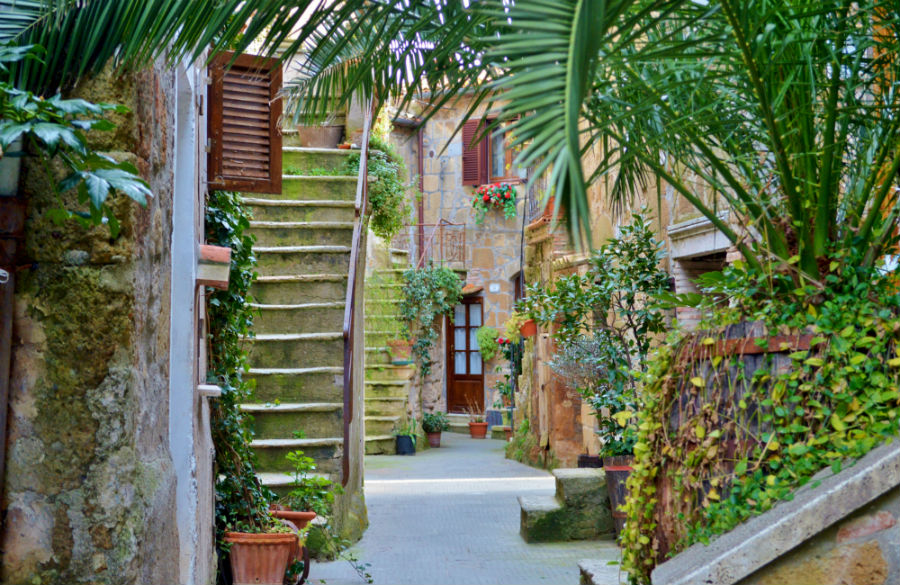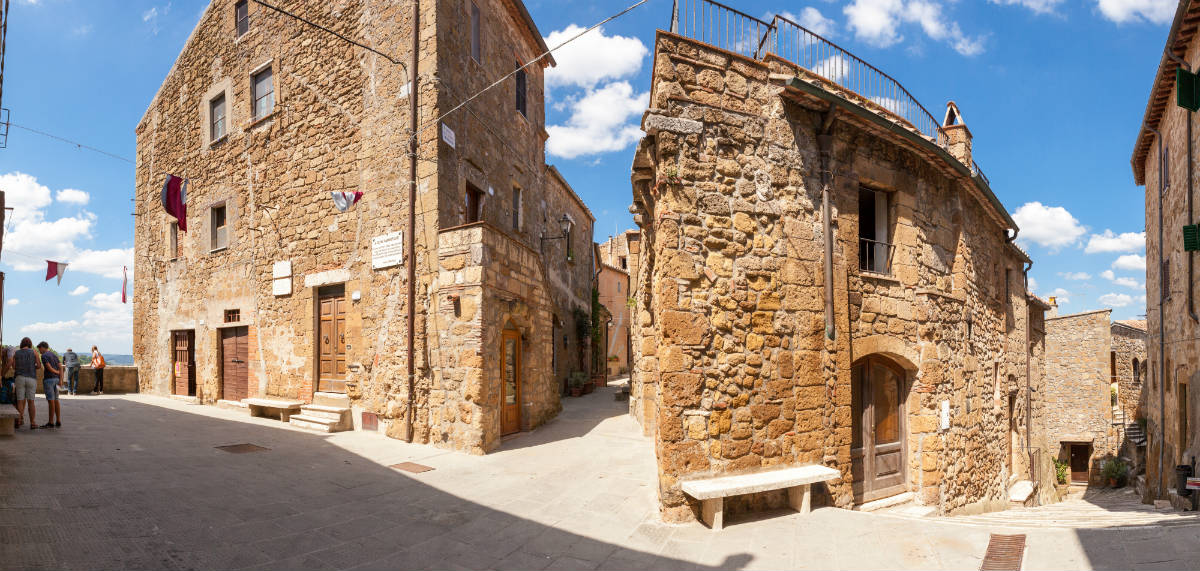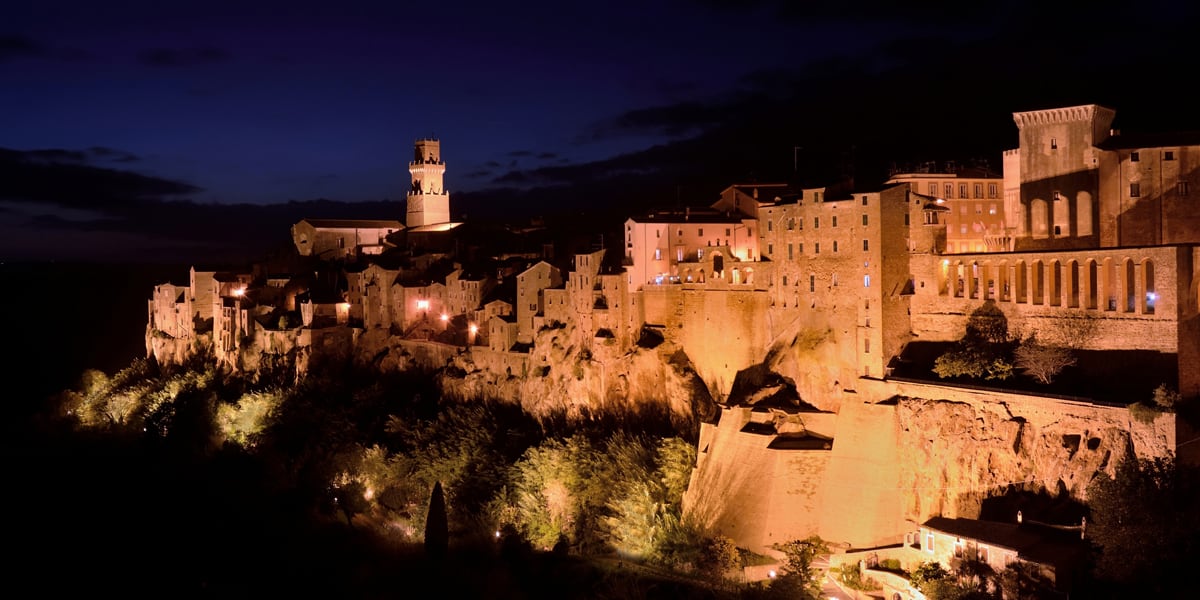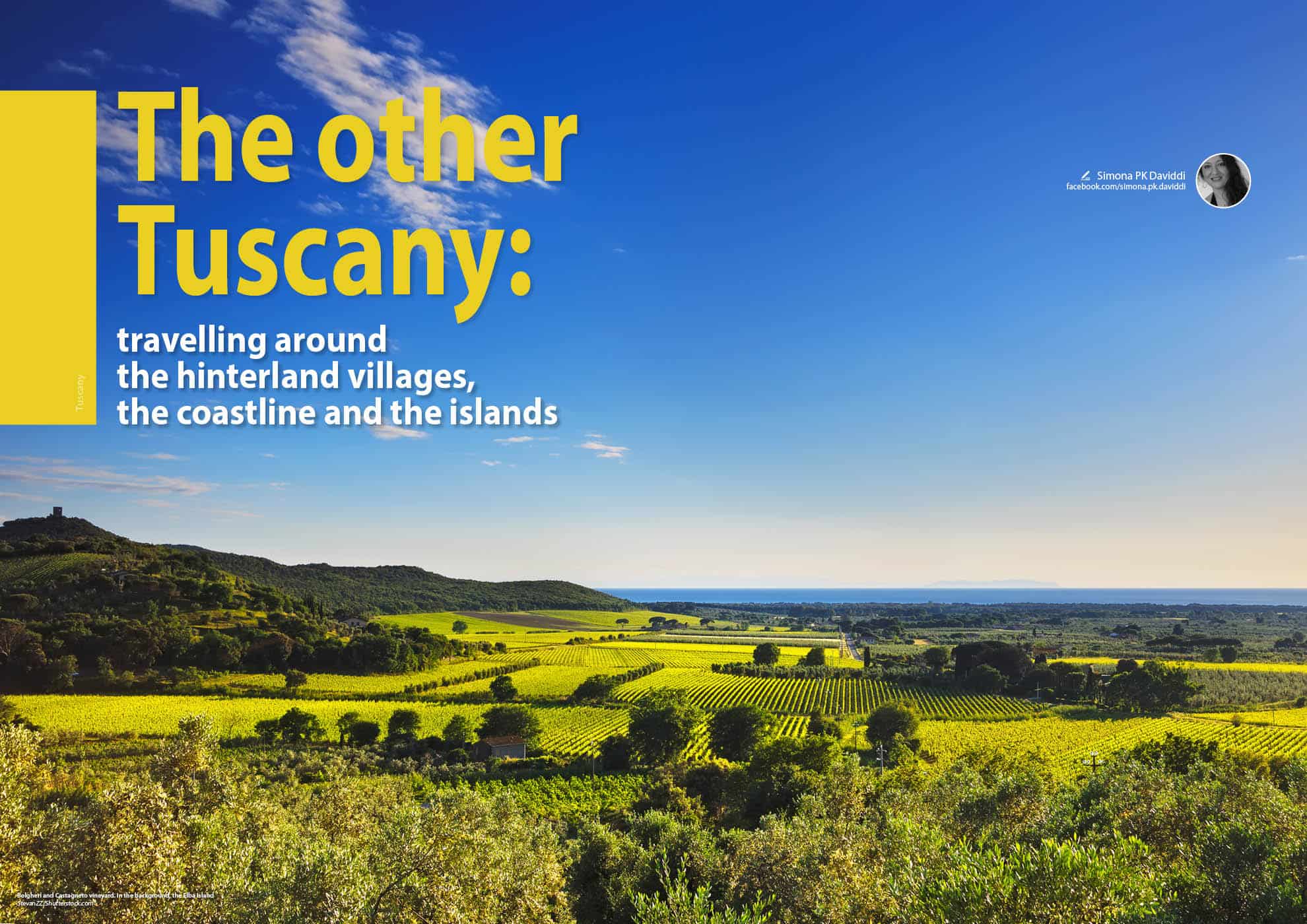Pitigliano
- Suitable for disabled people
- Camper parking area
- Most beautiful villages in Italy
- Orange Flag Countries
- City of wine
- Oil city
About the village
The characteristic village of Pitigliano is known as Little Jerusalem, for the historical presence of a Jewish community, always well integrated in a social context that here had their synagogue.
The territory extends in the western part of the area del Tufo. Arriving at Pitigliano from sea, climbing the regional road 74 Maremmana, you notice the characteristic houses that protrude from a great tuff spur, absolutely overhanging. The cliff of Pitigliano is surrounded on three sides by the same number of gullies, full of caves dug into the tufa; in the valley bottom slide watercourses Lens Meleta, and Prochio.
Pitigliano was already a place frequented and inhabited since Etruscan times, when here were founded numerous settlements excavated in the tufa and attested to by the late Bronze Age (XII-XI century a.C.). Even in the place where now stands the town was located an Etruscan center, witnessed by the remains of the walls that were discovered in the district of Capisotto and then disappeared between the end of the VI and the beginning of the V century b.c. The first news of Pitigliano appears in a bubble sent from Pope Nicholas II to the provost of the cathedral of Sovana in 1061, where it is already indicated as the place of jurisdiction of the family of the counts of Aldobrandeschi. In 1293 Anastasia, daughter of Countess Margherita Aldobrandeschi, married Romano Orsini bringing a dowry in the county of Sovana and the county seat was transferred to Pitigliano. The Orsini ruled the county of Pitigliano for centuries, difendendole by continuous attempts of submission by Siena and Orvieto before and the Medici Florence then.
As a testimony to the importance of the jewish community pitiglianese remain district of the old ghetto with its beautiful synagogue and the interesting cemetery on the highway to Manciano. The Synagogue of Pitigliano, sixteenth-century synagogue, inside which stand out the Aron on the bottom wall and the Tevà at the center; on the walls are preserved inscriptions of biblical verses while at the top you will find the women's gallery reserved for women. Under the Jewish Temple are the premises for the ritual bath, the suggestive oven of the unleavened breads, kosher butcher, the kosher wine cellar and the dyeing. The formation of the community dates back to the XVI century, but in the Nineteenth Century its decline begins. As a testimony to the importance of the jewish community pitiglianese remain district of the old ghetto with its beautiful synagogue and the interesting cemetery on the highway to Manciano. It is located beyond the torrent Meleta that delimits the south part of the village, built in the second half of the sixteenth century when the Orsini gave that land to their family doctor of the Jewish religion for the burial of his wife. In the vicinity of the Jewish cemetery extends the archaeological museum in the open Alberto Manzi.
Palazzo Orsini, an imposing fortified palace, built as a fortress by the Aldobrandeschi (XI-XII century) and then seat of the county of the Orsini, has been restructured consistently in the XVI century at the behest of Niccolò Orsini, on the project of the engineer Antonio da Sangallo the Younger. The complex houses the Diocesan Museum of Palazzo Orsini, rich in works of art that cover a period of time from the Middle Ages to the modern age, and the Civic Archaeological Museum, where are kept various finds coming from the nearby archaeological areas.
The Torciata di San Giuseppe is a traditional pitiglianese feast, which takes place every 19 march to celebrate the arrival of spring. The event consists of a historical parade in costume that parade through the streets of the historical center before you arrive in piazza Garibaldi, where we are seeing the spectacle of flag-wavers and, once the sunset, the fire by torciatori of a stack of faggots on which was placed a snowman of reeds, called "invernacciu", that is to symbolize the winter. Consumed the bonfire, the ashes are collected by women and preserved in homes as a sign of good luck.
The area in which rises Pitigliano is the production zone of the White wine of Pitigliano and red wine of Sovana, each of which has some variations on the basis of the production disciplinary.
Village of Pitigliano
The Municipality of Pitigliano
Province of Grosseto
Tuscany Region
inhabitants: 3.707 pitiglianesi
Altitude center: 313 m a.s.l.
The Municipality is part of:
I Borghi più belli d'Italia
Città del vino
Città dell'olio
Paesi bandiera arancione
Strada del Vino e dei Sapori Colli di Maremma
Unione Comuni Montani Colline del Fiora
Acknowledgments
Orange Flag - Italian Touring Club
Municipality
Piazza Garibaldi 37 - Tel. +39 0564 616322
3.00 Kilometers from Pitigliano
3.09 Kilometers from Pitigliano
3.10 Kilometers from Pitigliano
3.83 Kilometers from Pitigliano
6.46 Kilometers from Pitigliano
6.47 Kilometers from Pitigliano
16.38 Kilometers from Pitigliano
13.40 Kilometers from Pitigliano
78.38 Kilometers from Pitigliano
22.76 Kilometers from Pitigliano
16.35 Kilometers from Pitigliano
3.83 Kilometers from Pitigliano
BY CAR
- From the North: Take the A1 motorway towards Rome, exit at Orvieto, continue on the SS 71, cross Bolsena, take the SS 2 Cassia and then continue on the SS 74 following signs for Pitigliano.
- From the South: Take the Grande Raccordo Anulare following the direction for Florence, in Rome take the A1 Autostrada del Sole, exit at Orte and follow the direction for Viterbo, in Siena take the SS 2 and then continue on the SS 74 to Pitigliano.
- From Grosseto: Take the SS 1 Aurelia towards Rome, cross Albinia and continue on the SS 74 to Pitigliano.
- From Rome: Take the Roma - Civitavecchia highway, take the coastal highway towards Grosseto - Livorno, exit at Albinia, follow signs for Manciano and then for Pitigliano.
- From Genoa: Take the whole A12 highway, take the expressway towards Rome, exit at Albinia, continue on the SS 74 to Pitigliano.
ON THE TRAIN
- Albinia railway station
BY PLANE
- Rome Fiumicino Airport
- Florence airport
- Pisa airport
People who drive along the S.S. 74 Maremmana in direction of the sanctuary of the Madonna delle Grazie, cannot go without stop, enchanted and almost incredulous for the spectacle that is located ahead: the village of Pitigliano, suspended on its tufa cliff between green valleys. It is a magic vision, a lighting. The town of Pitigliano, totally built in tufa, is inserted into the landscape with such a compactness that it is almost impossible to separate the work of man from that of nature.
Here men over the centuries have preferred to dig more than to build. Thanks to the ease of working the volcanic rock, here was born a "civilization of tufa" of which have left impression the Etruscans, the people of the netherworld, and Jews, the people of the law. Digging tenaciously down to the bowels of the ground, the Etruscans built tombs, hypogea, tunnels and the mysterious "vie cave": their world was of dungeons, as if only entering into heart of the earth, by cutting the rock, could grasp its profound spirituality, to defeat the fear of death and go back to the light of the sun. Also the Jews who lived at Pitigliano for five hundred years, placed in caves the environments of their worship. Still today the spectacular town of Pitigliano hides under himself another underground city, made of rupestrian speakers, galleries and tunnels for water drainage, columbaria with the recesses for pigeons, stables, cellars and ancient rupestrian houses transformed into warehouses. In these environments are still vats, barrels, presses, crushers.
Discover the other villages on the guide Tuscany - Unique Villages to Love
Sleep, eat, buy...
30.65 Kilometers from Pitigliano
14.66 Kilometers from Pitigliano
11.92 Kilometers from Pitigliano
13.66 Kilometers from Pitigliano
13.11 Kilometers from Pitigliano
14.48 Kilometers from Pitigliano
14.67 Kilometers from Pitigliano
14.61 Kilometers from Pitigliano
13.58 Kilometers from Pitigliano
14.67 Kilometers from Pitigliano
11.04 Kilometers from Pitigliano
14.75 Kilometers from Pitigliano
78.68 Kilometers from Pitigliano
79.84 Kilometers from Pitigliano
78.27 Kilometers from Pitigliano
11.02 Kilometers from Pitigliano




















